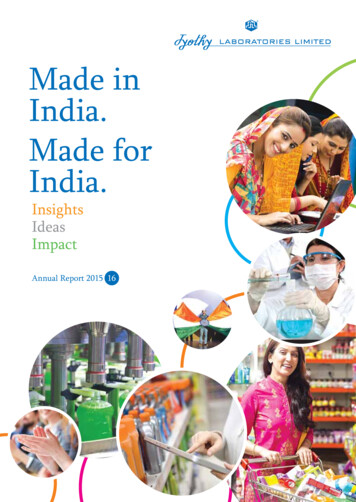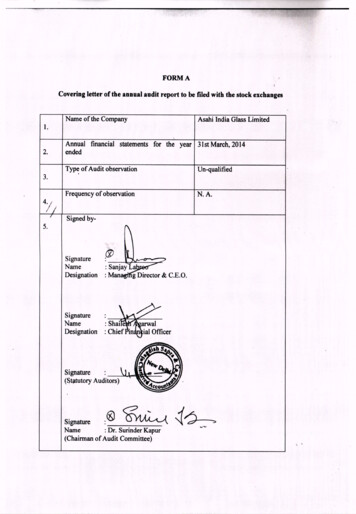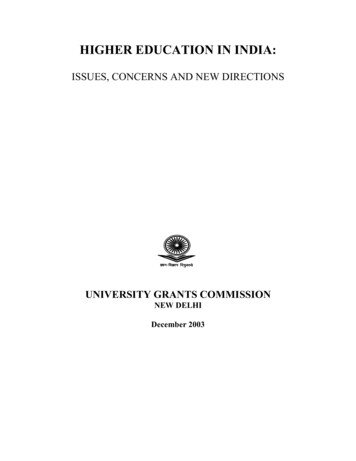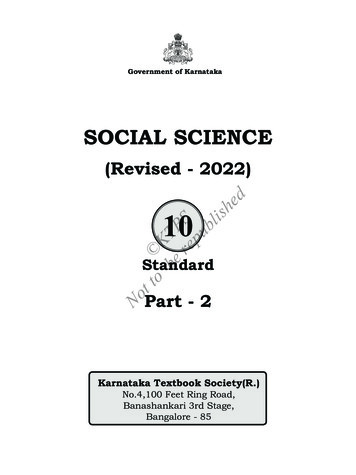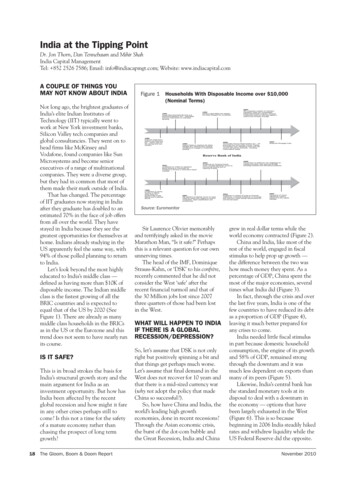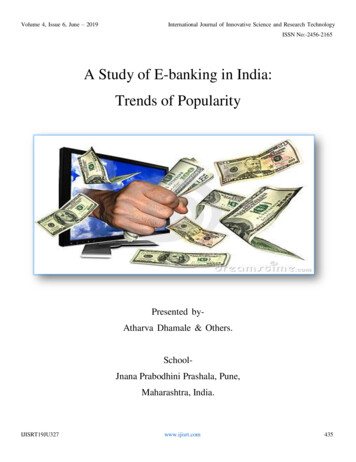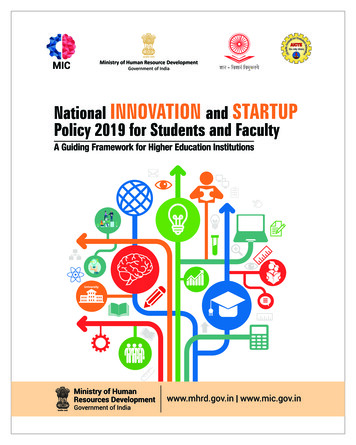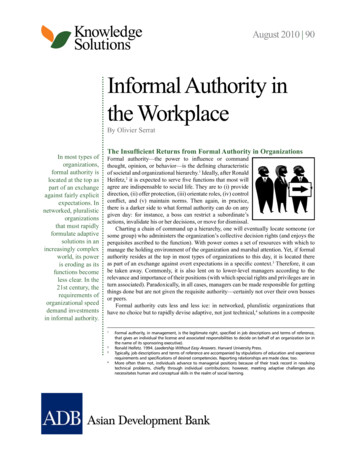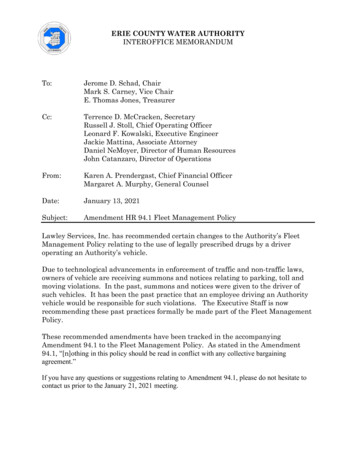
Transcription
Language in India www.languageinindia.com ISSN 1930-2940 Vol. 18:12 December 2018India’s Higher Education Authority UGC Approved List of Journals Serial Number 49042 Muktibodh and the Hour of Modernity in Hindi PoetryRohan Chauhan, M.Phil. Candidate AbstractGajanan Madhav Mukhtibodh is a Hindi poet and literary critic who can be counted as oneof the pioneers of literary modernism in India. He began by writing in the experimental orPrayogvad style and went on to be associated with the Nayi Kavita movement in 1950s. His earlypoetry appeared in the influential Tar Saptak anthologies where he opened new possibilities forHindi poetry in both style and form. Written as an incisive social critique, his poetical corpusdemands scholarly attention to add to the understanding of literary modernism in India. This paperis an attempt to appraise his poetry in order to shed some light on the facets of modernism in Hindipoetry.Keywords: Modernism, Hindi poetry, Gajanan Madhav Mukhtibodh, Nayi Kavita, PrayogvadEvery movement in arts has been modern for its time and context. In modernism, theaesthetic sensibility of the audience and artist matters rather than the mode of expression.Modernism as a term is used historically to “locate a distinct stylistic phase which is ceasing orhas ceased” (Bradbury and McFarlane 22). It emerged as a radical break from tradition and hasdifferent histories in different places. Any attempt to understand this phase in any region must takeinto consideration the social, political, economic, and cultural changes that fueled the alterationsin the aesthetic sensibilities of both the audience and the writer. Therefore, modernism must bestudied not as a homogenous entity but as heterogeneous strands of alternative modernities.Malcom Bradbury and James McFarlane in their study of literary modernism in Europe,entitled Modernism 1890-1930, define modernism as “the movement towards sophistication andmannerism, towards introversion, technical display, (and) internal self-skepticism” (Bradbury andMcFarlane 26). Modernism is characterized by the desecration of the established conventions oftradition. Writers in the modernist phase in Europe as well as in America not only rebelled againstthe rigidity of the form but also endorsed the anti-form. This shift in sensibility had to do a lot withthe change in the overall lifestyle of the bourgeoisie in Europe that came about with the fin desiècle. The change of century brought in new technologies that altered the way of living, whileseveral new disciplines like anthropology, psychology, and sociology offered new insights into thehuman mind changing the way humans reacted to their social realities. New media and faster Language in India www.languageinindia.com ISSN 1930-2940 18:12 December 2018Rohan Chauhan, M.Phil. CandidateMuktibodh and the Hour of Modernity in Hindi Poetry287
modes of communication changed how humans lived, hence ended up modifying the way theyreacted to their social circumstances.The modern phase in any Indian language literatures becomes highly difficult to trace andtheorize because there hardly exists any comprehensive account of the history of print journalismduring the twentieth century. Without an accurate description of the mainstream periodicals andlittle magazine, the politics of canonized and non-canonized is difficult to foreground. It has beenargued that various journals and little magazines established the idiom of modernism in themainstream. In these journals and little magazines, Indian writers writing in Indian languagesshaped the avant-garde idiom by borrowing freely from the west and contextualizing it with thenative tradition to reflect the contemporary social reality, making the modernist stance in Indianlanguages literatures both a “critique and extension of tradition” (Ramakrishnan 17).Sisir Kumar Das has pointed out that the early Indian writers who were writing in the ageof printing knew at least three languages: mother tongue, English, and a classical language, i.e.Sanskrit or Persian (Das 102). Therefore, any study concerning Indian literatures must take intoconsideration the three traditions that shaped the sensibilities of Indian writers, i.e. the pan IndianSanskrit tradition, the regional tradition, and the foreign tradition in urban societies. These threetraditions co-existed in regional languages and shaped its literary idiom. Modernity in the regionallanguages can be mapped by analyzing the “nature of their (the three traditions) combination” inliterary production (Ramakrishnan 19). The educated Indian elite, who produced and consumedmost of the literature in the post-print public sphere, aspired towards English as their “professionalambitions drove them towards English” (Ahmad 272), however they also remained rooted in theirown linguistic communities because of the “cultural pressure of their own lives” (Ahmad 272).This created a dialectic in the literary production in the colonial Indian state where the colonialintelligentsia drew from the vernacular desi tradition, the pan-Indian marga tradition, and English.By the end of first three decades of twentieth century, literature became institutionalized:only something that was “written, printed, and published” (Ramakrishnan 25) could be labeled asliterature. This institutionalization of literature excluded a large section of society from productionand circulation of literature and endowed this monopoly to the elite in the society, which widenedthe divide between the middle-class bourgeoisie and the masses. Literature in general and poetryin particular, in the hands of the educated bourgeoisie, was “fixed with [the] characteristics for theentire society” (Ramakrishnan 25) as per the ethos of this section of society. The effects of thiscan be seen in the poets of the Romantic movements all over India, which was also concomitantwith the nationalist movement. Poets during this time, like the chhayavadi poets in Hindi wrotenumerous poems, both long and short, that imagined a new vision of India, like JayashankarPrasad’s Kamayani. Legends were invoked to provide fodder for the nationalist movement. Poetry,during this period, tried to create a homogenous identity of society along the interests of the middle Language in India www.languageinindia.com ISSN 1930-2940 18:12 December 2018Rohan Chauhan, M.Phil. CandidateMuktibodh and the Hour of Modernity in Hindi Poetry288
class with “the increasing Sanskritisation of regional languages and a strong revivalist tendencytowards privileging certain types of collectivities” (Ramakrishnan 25). Due to the disparity inliteracy in society, a large section of population was denied any participation within this textualtradition of literary production, which created a gulf between these two sections of society and theway they perceived social realities and the nation-state.While generalizing the characteristics that triggered a modernist shift in the sensibilities ofpoetry in Indian languages, E.V. Ramakrishnan writes that “the appearance of the modernistsensibility can be interpreted as the dawning of a critical self-awareness which seeks to analyzeand reorder the relations between the public and private domains” (Ramakrishnan 22). Theimmediacy of this “critical self-awareness” arose as the relation between the dominant and thedominated changed radically with the demarcations of civil societies and state between the 1920sand 50s. The nationalist idiom of the 20s and 30s also affected this transition, as it drew heavilyfrom the Brahmanical tradition and allowed little space for “non-esoteric knowledge”(Ramakrishnan 26), which means that it curbed expression from the dispossessed sections ofsociety in the literary sphere and homogenized it along the interest of one section of society. Whilethe poets perceived this domination in the economic and the political sphere, they could onlychallenge it in the cultural domain, as it was the “autonomous domain where the poet could expresshimself” (Ramakrishnan 26).The growing gulf between the writer and the masses, “which meant the segregation ofliterary language as a distinct unit from non-artistic speech” (Ramakrishnan 26) was envisionedby the progressivist writers in the late 1930s. The poets writing within this movement took poetryaway from the idiom of the idealist and essentialist homogenization along the interest of the upperclass during the romantic phase. During the progressivist phase, poetry became a vehicle to depictdifferent moods of society and it opened up possibilities for discursive elements from differentstrata of society to enter the domain of poetry. However, it remained rooted in the framework ofthe romantic poets and continued to dehistoricize its subject. Though the content of poetrychanged, it followed the essentialist and universalist view of life developed by the romanticists.The rigidity of the form hardly opened up possibilities to depict the dismemberment of humanswithin society, while the diction remained far removed from the contemporary realty of society.The poets of this phase found the “entire past evolution of poetry in Indian languages of noconsequences to the present” (Ramakrishnan 26) and failed to “comprehend the problematic natureof the relation between the writer and his audience in modern society” (Ramakrishnan 27). Theyinvoked a view of the self as asocial and solitary and endorsed an idea of an “interior space whichis discontinuous with the common world of discursive speech and communal interaction”(Ramakrishnan 30). Language in India www.languageinindia.com ISSN 1930-2940 18:12 December 2018Rohan Chauhan, M.Phil. CandidateMuktibodh and the Hour of Modernity in Hindi Poetry289
This attitude to social reality was challenged by the poets of the experimental phase. Thepoets in this phase brought the literary language closer to the common speech and depicted thefragmentation of being in modern society by opening up the form in favor of the anti-form. SisirKumar Das informs us that it is not just the form of poetry that was challenged by the writers ofthis phase. The poets during this phase changed the “total linguistic texture of poetry, causingviolence in the accepted grammatical rules and syntactical patterns” (Das 218). He notes that the‘modernist’ phase in Indian poetry that aspired towards Eliot and Pound extends from 1930 to1950, while E.V. Ramakrishnan asserts that the ‘avant-garde’ phase in Indian poetry have beenestablished by the 1960s and 70s by looking towards models in Latin America and Africa. Thisavant-garde spirit in Indian poetry “opened up tradition and made it available as a site of conflict”(Ramakrishnan 26). During this truly modern phase of counter narratives in Indian poetry, thepoets resorted to self-criticism and moved towards the “discursive and the dramatic toaccommodate the multi-vocal quality of a hierarchically divided society” (Ramakrishnan 29).One of the primary distinctions that have to be made between high-modernism and avantgarde is the latter’s attempt at reconfiguring the gulf between high culture and low culture whilethe former is only preoccupied with high culture. Another important distinction between the twois argued by Peter Bürger in his book The Theory of Avant-Garde where he states that modernismcan be regarded as a revolt against the traditional techniques of writing while avant-garde is anattack to alter the practice of art as an institutionalized commerce (Bürger xv). In the foreword toBürger’s book, Jochen Schulte-Sasse states that within the development leading to symbolism andaestheticism, “form becomes the preferred content of the work” (Bürger xiii). This removed artfrom the “praxis of life” and intensified its separation from bourgeoisie society. For Bürger,aesthetic art has no social relevance, or in other words, art is beneficial for society only if itdiscusses socially relevant norms and values. Art moved towards the avant-garde, according toBürger, only when it started to question its own institution, i.e. its own social status. In highmodernism, values like “humanity, joy, truth, and solidarity” (Ramakrishnan 70) were preservedin literature, while they were removed from the praxis of life. Avant-garde challenged thepreservation of such values in art and defined expression of contemporary reality in art based onthe experiences in praxis of life.During the high-modernist phase of Indian poetry, a pan-Indian vision was evoked throughmyths that homogenized expereince and dehistoricized the subject by depoliticizing the individualexperience. Aesthetic modernism in Indian poetry projected an “abstract concept of man which, ina grand nationalist gesture, swept under the carpet the differences between dialects, classes,regions, and genders” (Ramakrishnan 73).The avant-garde idiom in Indian poetry rejected the grand mythopoetic vision of the nationin favor of “one’s own life story or myths of resistance and revolt” (Ramakrishnan 72) to recreate Language in India www.languageinindia.com ISSN 1930-2940 18:12 December 2018Rohan Chauhan, M.Phil. CandidateMuktibodh and the Hour of Modernity in Hindi Poetry290
contemporary history in a literary language that didn’t look back at the ruins of Sanskrit but wasderived from the common speech spoken in the cosmopolitan urban societies. The avant-gardepoetry in India challenged the entire tradition of art to “redefine both the practice and function ofart” (Ramakrishnan 28). It addressed various hierarchies of domination in the social system andpoliticized its subject by questioning the status quo.The proponent of such avant-garde spirit in Hindi poetry is Gajanan Madhav Muktibodh.His poetry is self-reflexive as he sets to critique the very medium in which he is writing. Thefragmentation of being that Muktibodh experienced was in excess “of the formal possibilitiespermitted by the existing forms of Hindi poetry” (Ramakrishnan 85). He not only opened up thepoetic form, but also challenged the “essentializing traits of the very tradition which constitutedhis self and sensibility” (Ramakrishnan 85). In his writings, he rose above his own individuality torealize the multiplicity and plurality of the modern world.Challenging the vision and ideology of the “elitist, metaphysical strain in the chhayavaadpoetry” (Ramakrishnan 87) which he saw as an endorsement of the status quo by the ruling elites,Muktibodh moved Hindi poetry away from equating Modernism with Europe and Americatowards drawing inspiration from the struggle of “emergent societies of Africa, Asia and LatinAmerica where the struggle for social change and reconstruction has brought in a new awakening”(Ramakrishnan 88). His poetry, rich in a tapestry of disjointed fleeting images, presents a “visuallanguage of protest which challenges the rational, ordered ways of representing the world”(Ramakrishnan 90). In order to extend and alter the horizon of expectation of the readers, he notonly rebels against the literary tradition in which he is rooted but also the reason and morality ofhis contemporary society.Critical of the way that the hegemonic order subsumes discursive elements within itself,Muktibodh goes back to the bhakti poets to show how they identified with the “genuine sufferingof the depressed classes” (Ramakrishnan 89), but were only appropriated by the ruling class. Hesees the same happening in his contemporary society where the ruling elites had appropriated andtamed the liberating potentialities of romanticism and progressivism to serve their own purpose.He wanted to free art of this institutionalization and to achieve it, he rebelled against the “processof domestication and perversion of creativity” (Ramakrishnan 89).Conscious of its creation, Muktibodh’s poetry is laden with irony and presents a critiqueof its own formation. He illustrates not only the fragmented nature of human lives, depicting thesociety and the individual in its most gory form, but also exemplify the “deviousness,disorientation, and degradation” (Ramakrishnan 90) of modern life. Language in India www.languageinindia.com ISSN 1930-2940 18:12 December 2018Rohan Chauhan, M.Phil. CandidateMuktibodh and the Hour of Modernity in Hindi Poetry291
Richard Sheppard in his essay dealing with Modernism in Europe, ‘The Crisis ofLanguage’, states that for a writer writing in modern societies language “ceases to be a luminousvehicle for self-expression and turns into something like an oppressive super-ego” (Sheppard 328).Within the oppressive social structures, literary language too becomes limited for the expressionof fragmented realities of society, as the bourgeoisie has already manipulated it for their own end.Language is seen as “de-potentiated, de-substantiated, and hollowed-out” and the writer, insteadof being a manipulator of language, “attempts to liberate the repressed expressive energies oflanguage,” and becomes an “experimenter” who tries to create a redeeming image out of chaos(Sheppard 329).Talking about this crisis of language faced by a writer writing in Hindi, Namvar Singhquotes Vijaydev Narayan Sahi in an essay entitled ‘Kavya-Bhasha aur Srijansheelta’ (PoeticLanguage and Creativity), compiled in the book Nayi Kavita ke Pratimaan to point out that a writercan only describe the changing realities of contemporary society in the rhythm of conversationallanguage, and the search for such rhythm is the search for poetic expression (Singh 105).Muktibodh’s anxiety for expression is evident in his poetic diction as he moves away fromthe two-dimensionality of the chhayavaadi poetic idiom, which he feels is manipulated by the eliteorder, and unfit to express the discontinuities of contemporary society. His poetry emerges fromthe crisis of language that Muktibodh sees as limiting the expression of banalities of the modernsociety, as he explains in an essay on Nayi Kavita that the upper-middle class has defined poeticlanguage according to its own aesthetic interest and circumscribed any divergence from this norm.This implies that a language of protest in poetry is deemed unaesthetic, and a direct or indirectcensorship is imposed on any expression that is true to the human suffering in contemporary socialreality (Singh 87-88).Muktibodh resorts to surrealist experimentation available to him in the works of writersabroad to achieve a poetic idiom that is faithful to contemporary social realities. The surrealistidiom helps him shock the readers out of their ‘horizon of expectation’ and re-conceptualizeaesthetics in Hindi poetry in the same manner as Surrealism has helped writers elsewhere to inventa “shock tactics by which the mind, conscious of its imprisonment, might in astonishment freeitself” (Sheppard 333). By taking up political responsibility to point out the power structures thatpervade in society, Muktibodh, within the surrealist framework of fantasy, seeks to demonstratelike other surrealist poets and painters that the “fantastic belies fantasy by being obstinately real”(Short 307). He borrows the idiom of surrealist fantasy but transforms and contextualizes it in thespecifics of the Indian tradition by addressing the contemporary reality with the evocation of thelost antiquities and a world of magic and ritual that is concomitant to it. Language in India www.languageinindia.com ISSN 1930-2940 18:12 December 2018Rohan Chauhan, M.Phil. CandidateMuktibodh and the Hour of Modernity in Hindi Poetry292
Typical of such expression, Muktibodh’s poem ‘Brahmarakshas’ evokes a surreal worldwhere a mythological figure is doomed to live in the abyss of a well with no hope of redemption.The central character of the poem, Brahmarakshas, a demonic figure, is “engaged in a relentlessact of cleaning himself” (Ramakrishnan 92), but finds it impossible to free himself of his sense ofguilt. Living in his narrow world of the well, he thinks himself superior to everyone in the world,which signifies the narcissistic self-validation of the middle-class:अति- प्रफुल्लिि कंटतकि िन-मन वहीकरिा रहा अनुभव की नभ ने भीतवनि हो मान ली श्रेष्टिा उसकी!! (Muktibodh 122)Hi ravaged body and mindForever believingthat even the heavens beseech himand acknowledge his superiority (Unkitsch)Despite his mastery of all recorded knowledge, he cannot see beyond the narrowperspective that the well offers him and believes that the moon and the sun are worshiping him asa guru when their light hits the inner walls of the well. He leads a conflicted life and finally perishesin the darkness of the well. The poem testifies the difficulty that the poet faces to express thecontemporary reality. In his faltering attempt to climb out of his nether worldly existence of selfdoubts, the Brahmarakshas in the poem, despite all his traditional knowledge, stands as a symbolof utter bafflement for every individual in the modern society who finds it difficult to come toterms with the changing socio-economic realities. Muktibodh’s use of the surrealistic frameworkof fantasy is an attempt to go back to the “pre-colonial sources of Indian experience”(Ramakrishnan 91), a return to native culture to shock the reader of mainstream Indian poetry“from his habits of viewing the world” (Ramakrishnan 34), and forge “a visual language that wouldconfront the contradictions of our modernist legacy” (Ramakrishnan 91).In Muktibodh’s poetry, the world of dream and magic coalesce to weave a narrative offantasy that critiques the very tradition in which it is rooted. The language he uses in his poeticdiction is closer to the common speech but stresses the fragmentation of subterranean self of thecommon person. One of his longer poems, ‘Andhere Mein’ (In Darkness) that was written afterone of Muktibodh’s book accepted by the Government of Madhya Pradesh as textbook at thesecondary level was banned on 19th September 1962 (Ramakrishnan 93), comments on the role ofthe common person in the emerging Indian state and nation building. Free of the formal rigiditiesof the Hindi poetic tradition and narrated as a dream sequence, the poem reads like a fantasy andbegins with a series of images that project the anguish of the unfulfilled self of the writer in thenew Indian state. It begins by invoking the image of Manu, who represents one strand in theimagination of the nation-state, as a possibility of this unfulfilled self: Language in India www.languageinindia.com ISSN 1930-2940 18:12 December 2018Rohan Chauhan, M.Phil. CandidateMuktibodh and the Hour of Modernity in Hindi Poetry293
कोई अनजानी अन-पहचानी आकृति।कौन वह तिखाई जो िे िा, परनहीं जाना जािा है !!कौन मनु ? (Muktibodh 127)An unknown unrecognizable apparitionWho is he that can be seen butNot recognizedWho? Manu?1The image of Manu refers to the order of nation building that aligns with the interest of theruling elites, but this image soon transits to the image of Tolstoy, representing socialism, toGandhi, representing a “semi-spiritualized nationalism” (Kumar 35), to the individual who in thewords of Muktibodh becomes the “very locus of social emancipation” (Kumar 36). Between thesestretches of fantasy, the poet stumbles into figures that address the state of contemporary reality ofthe nation. At one point he runs into a procession that is made up of “critics, thinkers, luminouspoets/ politicians, industrialists, and intellectuals/even city’s infamous murderer” (Muktibodh137)2 who upon sighting the poet, scream to kill him as he has learned about their mysteriousprocession in the dark of the night and might tell on them. All these people in the procession whobelong to the upper middle class, the poet implies, are complicit in the prevalent degeneration ofsociety. After evading this situation, the poet runs into a madman who lives in a banyan tree thatis a sanctuary for the downtrodden and deprived. By giving voice to this madman, the poet reflectsupon himself and his readers to show how the middle class is also responsible for the smoothfunctioning of the status quo. In ironical self-reflexivity, the madman asks the poet, and throughhim his readers, rather reprehensively:“अब िक क्या तकया,जीवन क्या तजया,जयािा तलया, और तिया बहुि-बहुि कममर गया िे श, जीवीि रह गए िुम!!” (Muktibodh 142)What have you done till now?How have you lived?Took more and gave lesserThe country died but you lived on3.1Translation is by the author of this paper.Translation is by the author of this paper.3Translation is by the author of this paper. Language in India www.languageinindia.com ISSN 1930-2940 18:12 December 2018Rohan Chauhan, M.Phil. CandidateMuktibodh and the Hour of Modernity in Hindi Poetry2942
Muktibodh’s poetry remains committed to the crisis in the modern Indian state where therole of the individual is constantly changing within the dynamic power structures that permeatethe capitalist society. His legacy lies in the fact that he is able to see the “identity crisis of [the]modern Indian as part of a larger socio-political and epistemological crisis” (Ramakrishnan 93).In his search for the ‘absolute expression’ (परम अतभव्यल्लि), Muktibodh preferred the longernarrative modes as it allowed him the liberty to accommodate the discursive and the dramatic inhis poetry. By giving voice to the downtrodden and disposed in his poetry, Muktibodh brings tothe domain of Hindi poetry a sensibility that is critical of the so called “culture of silence” of thedispossessed by the dominant order that keeps them “submerged” in the status quo so that theycannot see the means of their domination (Freire 30-33). His poetry emanates with issues that arepertinent in a post-colonial state where the imperial structures of domination have been replacedby the new order of nation formation. The constant impulse of self-criticism in his poetry is “anattempt to resist the domesticating traits of modernism” (Ramakrishnan 95). He is critical of theauthoritarian state that forcibly reconciles heterogeneous issues of society into a unifying whole.His modernity lies in his struggle for the democratization of the poetic space to accommodatemultiple views from different sections of society. Muktibodh’s status in Hindi poetry isexemplified not only by his contribution to the socially aware Nayi Kavita but also for laying thegroundwork for the protest poetry of the feminists in the 80s and Dalits in the 90s.BibliographyAhmad, Aijaz. In Theory: Classes, Nations, Literatures. London: Verso, 1992. Print.Bradbury, Malcom and James McFarlane. "The Name and Nature of Modernism." Bradbury,Malcom and James McFarlane. Modernism: 1890-1930. London: Penguin Books Ltd,1976. 19-54. Print.Bürger, Peter. The Theory of the Avant-Garde. Trans. Micheal Shaw. Minneapolis: University ofMinnesota Press, 1987. Print.Das, Sisir Kumar. A History of Indian Literarture: 1911-1956 - Struggle for Freedom: Triumphand Tragedy. New Delhi: Sahitya Akademi, 1995. Print.—. History of Indian Literature: 1800-1910 - Western Impact: Indian Response. New Delhi:Sahitya Akademi, 1991. Print.Freire, Paulo. Pedagogy Of The Oppressed. Trans. Myra Bergman Ramos. New York:Continnum International, 2005. Print.Kumar, Akshaya. Poetry, Politics and Culture: Essays on Indian Texts and Contexts. New Delhi:Routledge, 2009. Print.Muktibodh, Gajanan Madhav. Pratinidhi Kavitayen. New Delhi: Rakamal Prakashan, 1984.Print. Language in India www.languageinindia.com ISSN 1930-2940 18:12 December 2018Rohan Chauhan, M.Phil. CandidateMuktibodh and the Hour of Modernity in Hindi Poetry295
Ramakrishnan, E.V. Making It New: Modernism in Malayalam, Marathi, and Hindi Poetry.Shimla: Indian Institute of Advanced Study, 1995. Print.Sheppard, Richard. "The Crisis of Language." Bradbury, Malcolm and James MacFarlane.Modernism 1890-1930. London: Penguin, 1976. 323-336. Print.Short, Robert. "Dada and Surrealism." Bradbury, Malcolm and James McFarlane. Modernism:1890-1930. London: Penguin , 1976. 292-308. Print.Singh, Namvar. "Kavya-Bhasha aur Srijansheelta." Singh, Namvar. Kavita Ke Naye Pratiman.New Delhi: Rajkamal Prakashan, 1962. 93-109. Print.Singh, Namvar. "Tar Saptak: Itihaas ki Avrriti." Singh, Namvar. Naye Kavita Ke Pratimaan.New Delhi: Rajkamal Prakashan, 1962. 76-90. Print.Unkitsch. The Blind Demon Of Intellect. September 2016. Electronic. Februrary 2018. n-of-intellect . Rohan ChauhanM.Phil. CandidateDepartment of Modern Indian Languages and Literary StudiesUniversity of DelhiAddress: Room No. 4, D.S. Kothari Hostel, University of Delhi, 110007chauhan.rohan01@gmail.com Language in India www.languageinindia.com ISSN 1930-2940 18:12 December 2018Rohan Chauhan, M.Phil. CandidateMuktibodh and the Hour of Modernity in Hindi Poetry296
Muktibodh and the Hour of Modernity in Hindi Poetry 287 Language in India www.languageinindia.com ISSN 1930-2940 Vol. 18: . the romantic poets and continued to dehistoricize its subject. Though the content of poetry changed, it followed the essentialist and universalist view of life developed by the romanticists. .


